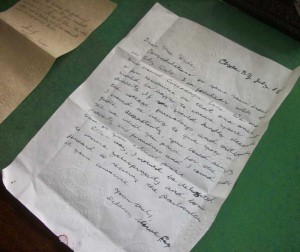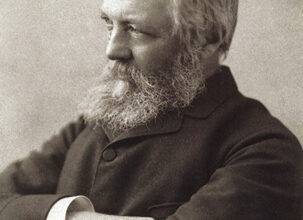Society changes schools’ cursive writing curriculum

It wasn’t so long ago that penmanship was one of the most important subjects in grammar school curriculum. But things have changed a lot in a short amount of time and now with email, computers, tablets, hand-held devices and phones, Twitter, Facebook, etc, etc, etc, the importance of word processing skills/keyboarding tends to take precedence over handwriting for many schools.
Common Core standards aren’t helping the cause for cursive. The standards require manuscript handwriting instruction until first grade and no mandated cursive instruction at any grade level. States, however, can choose to supplement Common Core with additional manuscript and cursive instruction.
Todd Yunker, principal at Churchville-Chili Fairbanks Road Elementary School, says cursive is offered in third grade. In fourth grade, students are encouraged to utilize cursive by writing out their papers.
“Beyond fourth grade, it’s the student’s choice,” Yunker says. “They can write in cursive or print. Now, most do their work keyboarding.”
Third graders are also taught keyboarding skills and in upper grades, technology skills are emphasized, Yunker says. For note-taking, netbooks are used as early as third and fourth grades, he adds.
At Spencerport Central Schools, cursive instruction is similar. Canal View Elementary principal Carol Robinson says cursive is taught in third grade.
“It’s viewed as a life skill,” Robinson says. “Fourth and fifth graders are strongly encouraged to use cursive as much as possible. It’s important to be able to produce as well as read it.”
By middle school, students are allowed “to create some system on their own,” Robinson says, “as long as its legible, it’s acceptable.”
She notes some cursive skill is necessary in adulthood – writing checks – for example.
Robinson says the school “also sees the value of technology – we see the importance of effective word processing, as well. We try to do a balance so they are fully prepared.”
Todd Yunker at Churchville-Chili observes, however, that if students abandon cursive completely as they move through grade school, “they no longer have that skill.”
The Clarkson Historical Society this fall offered cursive writing classes for anyone interested on two Sundays in an ongoing effort to keep cursive alive.
The classes were taught at the historic Clarkson Academy where cursive is also taught to area students during summer camp, as well as during the school year.
“Our whole history has been written with some kind of implement,” Clarkson Historical Society President Mary Edwards says. “And research shows there’s more to it (cursive) than a quaint idea.”
She explains that drawing and cursive go together, as well as the fact that if something is written down by hand, it is retained longer.
“The ability to think is correlated to the ability to write in cursive,” Edwards says.
And if you don’t have cursive writing skills, you don’t have cursive reading skills. You can’t read historical documents in their original form, or even personal family documents and letters from days gone by, Edwards notes.
“If you’re researching your uncle’s letters written during WWII, you’re up a creek if you can’t read cursive,” she says.
She also notes handwriting is a form of personal expression – something unique to each person.
Edwards passed along a list she found of 15 top reasons to teach handwriting. The list includes such benefits as:
•It is a complex skill that develops the brain
•Faster than printing
•Handwritten signatures are legally binding
•Higher SAT scores when written in cursive
•Not dependent on electronic technology
•Improves continuity and fluidity of thought in written communication
•Helps prevent memory loss
•Helps develop ability to focus
•Makes a child feel grown-up
•Handwriting humanizes a person vs. an email or text
Research and studies back-up Edwards’ arguments. On the website of Zaner-Bloser – a publisher of handwriting and literacy materials – a report by Hanover Research on the Importance of Teaching Handwriting in the 21st Century is posted.
In its executive summary, the report finds that proponents of cursive instruction suggest cursive benefits students’ motor skills and cognitive development, is a necessary back-up skill to technology, can boost academic achievement, and aides students with learning disabilities.
The report lists an impressive number of benefits of formal handwriting instruction including:
•Increasing brain activation
•Impacts performance across all academic subjects
•Provides a foundation for higher-order skills
•Influences reading, writing, language, and critical thinking
The report found that students who are not proficient in handwriting may be as high as 25-33 percent of the student population.
“The art of putting pen to paper helps students to ‘absorb knowledge’ in a way that visual or audio learning cannot,” the Hanover Research report states.
Cursive can play a role in a person’s self-definition, holds a place historically and culturally in the United States, and is a useful back-up skill for cases when technology may not be available, the report found.
Students may also need something to fall back on – job applications may require candidates to write more than a line or two, for example.
“Similarly, students unable to read cursive may be at a disadvantage if they need to reference documents produced in a pre-technological era such as the Declaration of Independence. Students may also need to read cursive if a teacher provides handwritten feedback,” the report says.
Finally, the report states cursive writing may be beneficial for students with learning disabilities such as dyslexia because the “built-in mechanics of cursive help to solidify word-order comprehension.”
Kathy Best learned cursive via the “Palmer Method” from the nuns at St. John the Evangelist School in the 1950s.
“There was a banner above the chalkboard that ran the width of the classroom.
It showed both uppercase and lowercase letters,” she fondly remembers. “We were given white lined paper to practice on. The paper always had to be placed on a slant to the left so that our handwriting would slant to the right. I remember starting with series of attached loops. You drew these over and over again until you developed good muscular coordination in the arm and wrist. Then you went on to practice the alphabet starting with the lowercase ‘a’ then the uppercase. The nuns were very strict about perfecting each child’s handwriting.”
Handwriting was practiced daily and it could take days to master a lowercase or uppercase letter, Best says.
“I believe this kind of discipline helped develop not only coordination, but also a child’s fine motor skills, and we were graded according to skill. I think I usually got a ‘B.’ Good penmanship gave students a sense of pride and accomplishment,” Best says, “… and made the nuns very happy. Cursive may take a little longer to learn, but it is an easier and faster form of communication than printing.”
A teacher of Best’s children in the 1980s was so impressed with the “Palmer Method,” she taught it to herself and then to her students, Best says.
She explains that so much history is recorded via cursive handwriting and it is also a skill that teaches patience, perseverance and creates new neural pathways.
“I am so thankful to those dear, sweet nuns who cared enough about each of their students to teach the basic skills we all need. Reading, writing and arithmetic – and we were graded on how well we did; and yes, some students were ‘left behind’ until they learned.
“I can’t imagine sending off a sloppy thank-you card to someone who has shown me a kindness,” Best continues, “or writing a letter with such sloppy penmanship that the recipient can’t even read it. I don’t know what today’s children will do if there is a war and no cell towers. It seems common sense to me that basic skills should be taught and reinforced, and technology (a wonderful tool) should be an enhancement of today’s learning process.”
If you feel the same way about preserving cursive handwriting in our culture, mark your calendar to celebrate an annual holiday of which you may not be aware. January 23 is National Handwriting Day and has been for decades. That date was chosen as it is the birthday of John Hancock, one of our founding fathers whose memorable signature graces the Declaration of Independence and whose name has become synonymous with signing one’s name. If you can sign your name, that alone may be a reason to celebrate.





